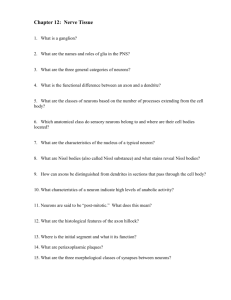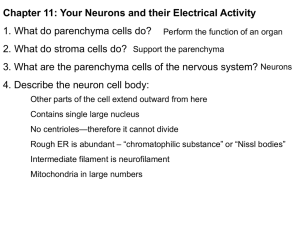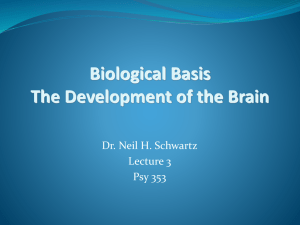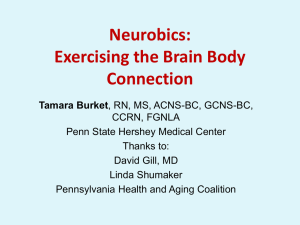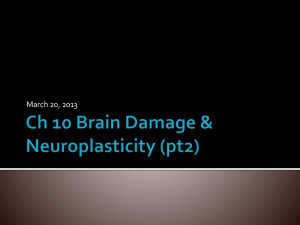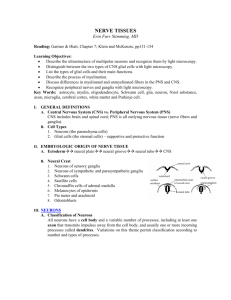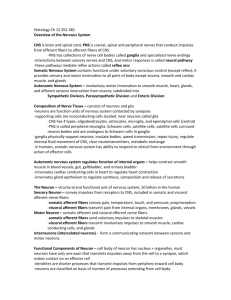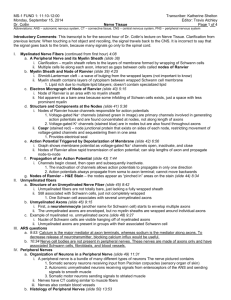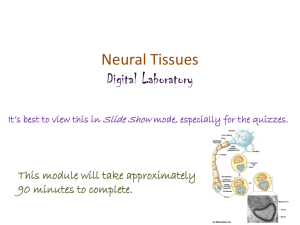Histology of Nervous Tissue
advertisement
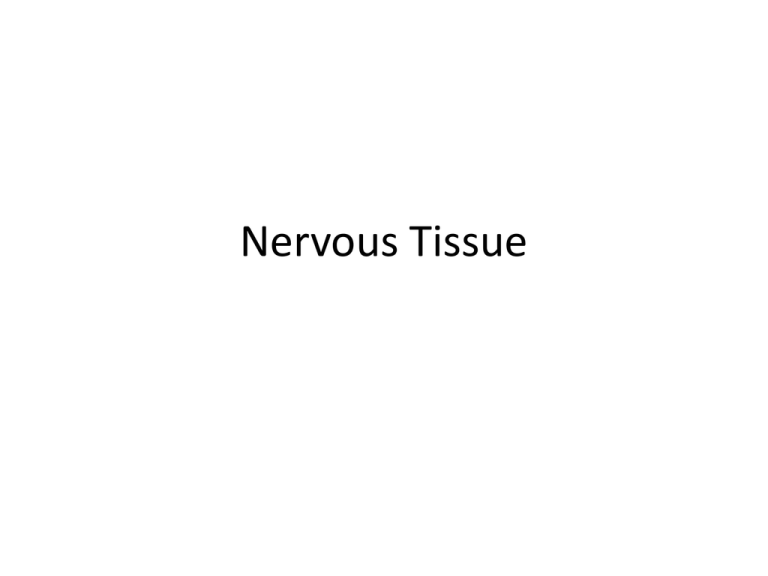
Nervous Tissue A. Nervous tissue is divided anatomically into the central nervous system (CNS), which includes the brain and spinal cord, and the peripheral nervous system (PNS), which includes the nerves outside the CNS and their associated ganglia. • B. Nervous tissue is divided functionally into • Somatic nervous system (SNS) • Autonomic nervous system (ANS) • Somatic- provides sensory and motor innervation to ALL parts of the body • EXCEPT: viscera, smooth muscle and glands • Autonomic- provides efferent Involuntary motor innervation to smooth muscle, conducting system of the heart and glands. • It provides afferent sensory innervation from viscera ( PAIN and REFLEXES ). • Autonomic is subdivided into Sympathetic and Parasympathetic division. • C. Nervous tissue contains two types of cells: nerve cells (neurons), which conduct electrical impulses. • Supporting cells: • Neuroglia (glia) in the CNS • Schwann , satellite cells in the PNS • 1. Morphologic classification of neurons • a. Unipolar neurons possess a single process but are rare in vertebrates • b. Bipolar neurons possess a single axon and a single dendrite. These neurons are present in some sense organs (e.g., the vestibular/cochlear mechanism). • c. Multipolar neurons possess a single axon and more than one dendrite. • These neurons are the most common type of neuron in vertebrates. • d. Pseudounipolar neurons possess a single process that extends • from the cell body and subsequently branches into an axon and dendrite. • They are present in spinal and cranial ganglia. • 2. Functional classification of neurons • a. Sensory neurons receive stimuli from the internal and external environment. • They conduct impulses to the CNS for processing and analysis. • b. Interneurons connect other neurons in a chain or sequence. They most commonly connect sensory and motor neurons; they also regulate signals transmitted to neurons. • c. Motor neurons conduct impulses from the CNS to other neurons, muscles, and glands. Neuron structure • 1.The nucleus is large, spherical, is centrally located in the soma of most neurons. • 2.Nissl bodies are composed of polysomes and rough endoplasmic reticulum (RER). • 3.The Golgi complex is located near the nucleus, and mitochondria are scattered throughout the cytoplasm • Dendrites receive stimuli (signals) from sensory cells, axons, or other neurons and convert these signals into small electrical impulses (action potentials) that are transmitted toward the soma. • The dendrite cytoplasm is similar to that of the soma except that it lacks a Golgi complex. • Organelles become reduced or absent near the terminals except for mitochondria, which are abundant. • Spines located on the surface of dendrites increase the area available for synapse formation with other neurons. • Axons conduct impulses away from the soma to the axon terminals without any diminution in their strength. • (1) The diameter and length of axons in different types of neurons vary. Some axons are as long as 100 centimeters (cm). • • (2) Axons originate from the axon hillock, a specialized region of the soma that lacks RER and ribosomes but contains many microtubules and neurofilaments; abundance of the latter may regulate neuron diameter. • (3) Axons may have collaterals, branching at right angles from the main trunk. • (4) Axon cytoplasm (axoplasm) lacks a Golgi complex but contains smooth endoplasmic reticulum (SER), RER, and elongated mitochondria. • (5) A plasma membrane surrounds the axon and is called the axolemma. • (6) Axons terminate in many small branches (axon terminals) from which impulses are passed to another neuron or other type of cell. • • • • Neuroglial cells Astrocytes Astrocytes are the largest of the neuroglial cells Functions: (a) Astrocytes scavenge ions and debris from neuron metabolism and supply energy for metabolism. • (b) Form a protective sealed barrier between the pia mater and the nervous tissue of the brain and spinal cord. • (c) They provide structural support for nervous tissue. Types of astrocytes • A. Protoplasmic astrocytes reside mostly in gray matter and have branched processes that envelop blood vessels, neurons, and synaptic areas. • B. Fibrous astrocytes reside mostly in white matter and have long, slender processes with few branches • Oligodendrocytes • Oligodendrocytes are neuroglial cells that live symbiotically with neurons. They are necessary for the survival of neurons • They are located in both gray matter and white matter. • They possess a small, round, condensed nucleus and only a few short processes. • Their electron-dense cytoplasm contains ribosomes, numerous microtubules, many mitochondria, RER, and a large Golgi complex. • Oligodendrocytes produce myelin, a lipoprotein material organized into a sheath that insulates and protects axons in the CNS. Each oligodendrocytes produces myelin for several axons. Schwann cells • Schwann cells are flattened cells with only a few mitochondria and a small Golgi region. • These cells perform the same function in the PNS as oligodendrocytes in the CNS: they protect and insulate neurons. Schwann cells form either unmyelinated or myelinated coverings over neurons. • A myelin sheath consists of several Schwann cell plasmalemmae wrapped around a single axon Synapses • 1. Site of synaptic contact • a. Axodemiritic synapses are located between an axon and a dendrite. • b. Axosomatic synapses are located between an axon and a soma. • The CNS primarily contains axodendritic and axosomatic synapses. • c. Axoaxonic synapses are located between axons. • d. Dendrodendritic synapses are located between dendrites • 2. Method of signal transmission • a. Chemical synapses • These synapses involve the release of a chemical substance (neurotransmitter • or neuromodulator) by the presynaptic cell, • b. Electrical synapses • These synapses involve movement of ions from one neuron to another via gap junctions Nerve Fibers • Nerve fibers are individual axons enveloped by a myelin sheath or by Schwann cells in the PNS (or oligodendrocytes in the CNS). • A. Myelin sheath • 1. The myelin sheath is produced by oligodendrocytes in the CNS and by Schwann cells in the PNS. • 2. It consists of several spiral layers of the plasma membrane of an oligodendrocyte or Schwann cell wrapping around the axon. • 3. It is not continuous along the length of the axon but is interrupted by gaps called nodes of Ranvier. • B. Nodes of Ranvier are regions along the axon that lack myelin and represent discontinuities between adjacent Schwann cells (or oligodendrocytes). • 1. In the PNS, the axon at the nodes is covered by Schwann cells. In the CNS, however, the axon may not be covered by oligodendrocytes. • 2. The axolemma at the nodes contains many Na+ pumps and displays, in electron micrographs, a characteristic electron density. Ganglia • Ganglia are encapsulated aggregations of neuronal cell bodies (soma) located outside the CNS. • A. Autonomic ganglia are motor ganglia in which axons of preganglionic neurons synapse on postganglionic neurons. • B. Craniospinal ganglia are sensory ganglia associated with most cranial nerves and the dorsal roots of spinal nerves (dorsal root ganglia). Unlike autonomic ganglia, craniospinal ganglia do not have synapses. • neuron

